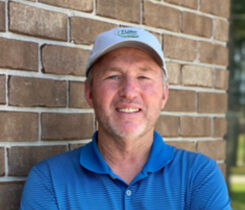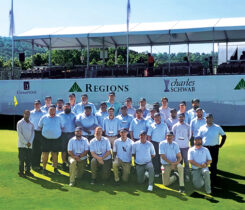A preview of Bethpage Black Course, host of the 2019 PGA Championship
With a nod to his local roots, Andy Wilson and his crew at Bethpage are readying the Black Course for the 2019 PGA Championship
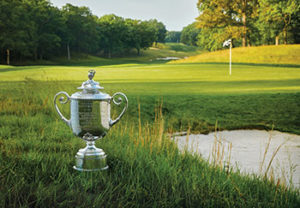
The Wanamaker Trophy, the top prize at the PGA Championship, awaits its next recipient at this year’s tournament site, Bethpage’s Black Course. (Photo: The PGA of America)
Bethpage’s Andy Wilson has his eye on the calendar. “It’s under 80 days until the tournament … so in three months, it’ll be over,” he says, sounding a little wistful.
As Bethpage’s director of grounds, responsible for spearheading operations for the 101st PGA Championship, to be played on Bethpage’s prestigious Black Course, Wilson hardly can believe that the tournament will be a memory come Memorial Day weekend.
A mainstay on Golf Digest’s “America’s 100 Greatest Golf Courses” list (this year it ranks at No. 37) and located in Long Island, N.Y.’s Bethpage State Park, Bethpage’s Black Course is one of the country’s toughest public courses, with the equivalent of a homeowner’s “Beware of Dog” sign on the first hole, warning golfers of its difficulty.
“It eats people up, but they love it,” Wilson says, shaking his head. “They’re crazy — I don’t even like playing it, it’s so hard. I go play the Green.”
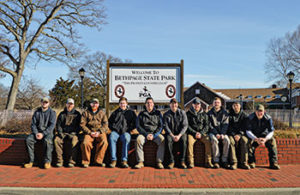
The Bethpage superintendent team. From left: Ryan Murphy, Michael Hadley, Eric Newell, Andy Wilson, Vincent Herzog, Sean Brownson, Shawn Brownell, Jake Suelflow, Hamilton Lopes and Erik Feldman. (Photo: Abby Hart)
Course preferences aside, Wilson is immensely proud of his career at Bethpage and the quality of golf it continues to offer local golfers and golf fanatics alike.
“Being a public course, and especially because I live local and I grew up local — I take that seriously,” he says. “We want the golf course to look good, and I think the people have a lot of pride in their golf course.”
With the 2019 PGA Championship moving from August to May — the first time in 70 years that the tournament will be played in May — the team is ready to prep the Black for its latest challenge and keep up the pride among Long Island locals.
Bethpage beginnings
In the early 1930s, the Bethpage Park Authority purchased Lenox Hills Country Club and hired golf course architect A.W. Tillinghast to design and oversee construction of the Black, Red and Blue Courses. Tillinghast also redesigned the Lenox Hills Course, which became the Green Course. The fifth and final course, the Yellow Course, was designed by Alfred Tull and opened in 1958.
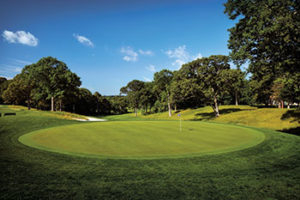
Bethpage Black saw major restorations in preparation for the 2002 U.S. Open,
with additional work completed before the 2009 U.S. Open. (Photo: The PGA of America)
Having grown up in the town of Bethpage and now living 10 minutes away in Farmingdale, which borders the state park, Wilson has spent most of his life in and around Bethpage. He first started working at the club in the summer of 1989, has been full time since 1994 and has held many positions there, including selling greens fees tickets and maintaining the tennis courts and polo fields.
During his early years at the club, the golf course was managed by local retirees who saw working on the golf course as a useful second career that allowed them time to play golf. Craig Currier joined Bethpage in 1997 and brought with him a professional turf manager’s outlook to overseeing Bethpage’s five courses.
Seeing promise in Wilson, Currier and former Parks Director Dave Catalano encouraged him to attend turf school at Rutgers. (He already had completed his bachelor’s degree in English at Fairfield University. “I did much better in my turf degree,” he admits.)

In addition to the 2019 PGA Championship, the A.W. Tillinghast- designed Bethpage Black will also host the 2024 Ryder Cup. (Photo: John R. Johnson / Golfphotos.com)
Wilson became Green Course superintendent in 2000 and over time became overall assistant to Currier. When Currier took a short 12-mile jaunt west on the Long Island Expressway to become the superintendent at Glen Oaks Club, Wilson stepped into the director of grounds role on Jan. 1, 2010.
Space to grow
Wilson’s approach to his greenkeeping team, in particular the superintendents on the Black Course as they look ahead to May, is to give them plenty of information and allow them the space to do their jobs and develop their skills.
With five golf courses and a crew of 50 to 60 people, Wilson reasons that the operation is big enough that people have the flexibility to figure out what they like to do and express their natural talents.
“I tend to give guys a little leeway to see what they can do with that freedom,” Wilson says. “When they reward you with good conditions, it’s great.”

Photo: Abby Hart
Pittsburgh native and Penn State grad Michael Hadley is superintendent on the Black Course. In his 20-year career at Bethpage, he’s seen the course undergo renovations and major changes alongside Wilson — sometimes a little too close, like when they shared a small office across from what is now Wilson’s office.
During Wilson’s and Hadley’s tenures at Bethpage, they’ve worked the 2002 and 2009 U.S. Opens (won by Tiger Woods in 2002 and Lucas Glover in 2009) and the 2012 and 2016 Barclays tournaments (won by Nick Watney in 2012 and Patrick Reed in 2016).
The 2019 PGA Championship will be their third major and has given them their first opportunity to work with the PGA of America, with PGA Tour and USGA experience already under their belts. The PGA of America will be the seventh organization to host a tournament at Bethpage.
“You have to have trust,” Hadley says about the close-knit team. According to him, it’s necessary for the greenkeeping crew to communicate well with each other — allowing Wilson to focus on the business around the golf course and the superintendents to take care of the turf.
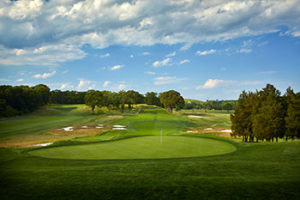
Rees Jones and Greg Muirhead have worked with the Bethpage team and the PGA of America to modify hole No. 18 on the Black Course in preparation for May. (Photo: The PGA of America)
Construction Superintendent Vincent Herzog agrees. “(Andy) remembers what it’s like, and he just wants us to have the information. I don’t think there’s ever a point where it’s too much.”
Herzog was a high school golfer in Ohio and studied turf science in Alabama. Wilson hired him as an intern in the summer of 2010, and he packed his Ford Ranger for Long Island and finished his turf degree from his new home in New York.
Over the years, Herzog moved up from assistant on the Black Course to superintendent on the Red Course and moved up yet again last fall to become construction superintendent, overseeing construction projects across all five courses. This includes the massive infrastructure necessary to support the PGA Championship crowds.
Black Course Assistant Superintendent Ryan Murphy played golf for most of his life growing up in Massachusetts, which led him to study sports management and golf management.
Murphy applied for a job at Bethpage in 2012 during the first Barclays and hasn’t looked back. “I honestly fell in love with it — being out with the guys in the field and working through the summer.”
He says that so far this season, the course looks good and the work is “really detail oriented. I feel like we’re able to get the Black Course really dialed in year to year, and it’s about maintaining that.”
Not all members of the team had a prior love of golf. Head Mechanic Sean Brownson was on his way to becoming a pilot when he arrived on Long Island in 2007 for aviation training at Farmingdale State College. He took a job working on the golf courses at Bethpage and got his first taste of the tournament atmosphere when he worked the 2009 U.S. Open on the Black Course.
Even with his training completed and his pilot’s license in hand, the experience changed his life forever. “The excitement and the preparation, it just kind of drew me in, and I said, ‘This is what I want to do,’” Brownson says.
As it turns out, he had a recent opportunity to get that tournament rush at the 2018 U.S. Open at Shinnecock Hills, Bethpage’s neighbor that’s an hour east on Long Island, where his younger sister Lindsay served as assistant superintendent under Jon Jennings, CGCS. Brownson says he’s been getting his sister’s advice as the Bethpage team gears up for its big week.
Long Island in the spring
The Bethpage tournament crowds are famously rowdy, with 2016 Barclays winner Patrick Reed comparing the noise level to a football game. This superintendent crew is working hard to ensure that the players and the spectators have plenty to cheer about as far as course conditions — even with the date changing from late summer to spring.
Wilson started to get an inkling that schedule changes were in motion three years ago when PGA of America Chief Championships Officer Kerry Haigh asked him what the weather was like in Bethpage in May.
“That was sort of curious, a guy who was pretty high up the food chain, why’s he asking a humble civil service employee like myself — a municipal superintendent — about the weather in May,” Wilson laughs.
Considering the course’s Poa annua greens are in better condition in May than in the thick of a long season in August, making the move “put a smile on our faces,” he says, noting that the course’s Poa greens typically are at their best mid-May to mid-June.
The Black Course superintendents treated last winter and spring as a sort of rehearsal for this year. The greenkeeping team’s biggest concern is winterkill — really any winter damage. Hadley adds that the team has been experimenting and working with the PGA of America on Poa seedhead control.
Getting championship ready
The team is staying on their game and making changes to ensure the grounds crew is successful in May. However, some changes on the course are designed to take the already formidable Black Course to another level for the pros.
Rees Jones and architect Greg Muirhead have been intricately involved in renovations at Bethpage, with Jones visiting at least twice a year and Muirhead visiting a handful of times throughout the year.
Between the 2012 Barclays and after the 2016 Barclays, the greenside bunkers on the Black Course were rebuilt. The No. 11 green has a new extension on the back left of the hole, and a few more pin positions have been added.
Some additional alterations to the course include planting trees on the right side of the fairway on No. 1 and reshaping and rebuilding bunkers on No. 3. The No. 14 green has been rebuilt to add Championship hole locations.
The most dramatic changes have occurred on No. 18. Back in 2009, the front of the 18th fairway offered a generous bailout area about 30 yards wide, which pinched down to about 19 yards wide. In previous tournaments, players have chosen a conservative approach on that hole, choosing to lay up in the front fairway area.
The 411-yard hole was good looking but not ultrachallenging, Wilson concedes.
Now the fairway has been contoured to about 24 yards wide throughout, forcing golfers to be more accurate with their
approaches.
Two additional bunkers on the right side of the 18th green were designed to offer some additional obstacles. “If someone does lay up in there and they miss, there is a little bit of danger to get there from a fairway bunker 160 yards out,” Wilson says.
Jones is complimentary of the Bethpage team and the work they’ve put in. “(Black Course superintendent) Mike Hadley’s a superstar,” he adds.
After all the adjustments to the course, how does he think it stands up as a host for this year’s PGA Championship?
“It’s a great test,” Jones says. “It’s got some very strong holes … it’s got a great ebb and flow.”
Jones says that with pros hitting longer drives and hitting shorter clubs and a number of elevated greens on the course, Bethpage works for the game that current pros tend to favor.
“They don’t play the ground game as much,” Jones says. “Because they play the aerial game, it suits them perfectly for the PGA Championship.”
There’s no place like home
Wilson has made a point of hitting the road and visiting tournaments to gain perspective on the agronomic side, learning about organizing volunteers, working with vendors and seeing firsthand the scale and what it takes to run a major — basically, what “the show within the show” is.
At Baltusrol in 2016, he spoke with the superintendent of another Tillinghast-designed course, Mark Kuhns, CGCS, during that year’s PGA Championship. He made the trek up north to Hazeltine to work on Chris Tritabaugh’s data team during the 2016 Ryder Cup.
Last year, Wilson Stimped greens at Bellerive Country Club for Carlos Arraya, CGCS, for the 2018 PGA Championship. He wrapped up 2018 by crossing the pond for the Ryder Cup at France’s Le Golf National, where he had the opportunity to ride around the course with Haigh.
After all his travels, he found that Bethpage Black isn’t lacking.
“It’s a matter of attention to detail, but it seemed like all these guys were doing a lot of the same things,” he recalls. “A few different techniques, but most of it involved organization, motivation and diligence ahead of time.”
“It’s nice, because I see those other golf courses and I think, ‘Hey, we’re in their league,’” he says.
Not bad for a local Long Island kid and a humble municipal superintendent.









